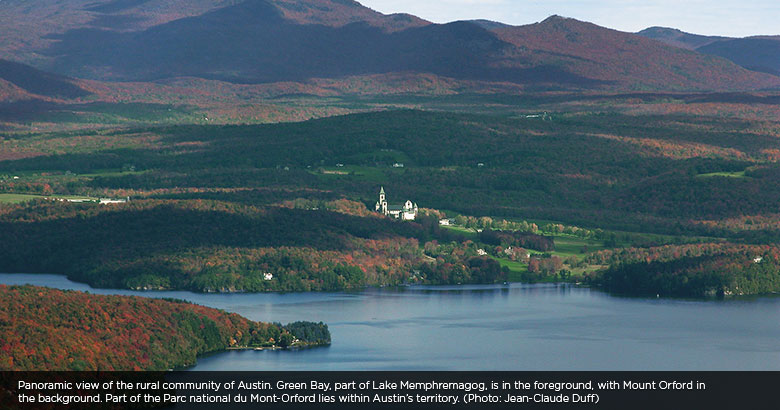An innovative plan for a prime Quebec resort area
Known for its beautiful scenery, rich biodiversity and major ecosystems, Austin adopted a sustainability action plan for what is considered one of the prime resort areas in Quebec. This innovative plan is based on excellent knowledge of the forest, lakes and wetlands. It serves as a comprehensive management reference for sustainability in governance, the environment, the economy and society.
Read the case study below to learn about project highlights, as well as the challenges and lessons learned that can help your community in planning similar projects.

About the project
| Municipal population | Project duration | Total project value |
|---|---|---|
| 3,515 (1,507 permanent and 2,008 seasonal) | February 2013–December 2014 | $107,200 |
Before beginning to work on its action plan, Austin wanted to determine the areas in which residential and commercial development could be appropriately implemented. This involved evaluating and mapping the load capacity of the municipality's land and water ecosystems.
Strategic planning was supported by a collaborative approach that for nearly two years engaged elected officials, citizens, local organizations and stakeholders. This approach gave rise to a strong common vision upon which the municipality built a structured action plan focused on four main areas:
- protecting and enhancing heritage
- making the community and living environment dynamic and lively
- aligning development with the community's vision and values
- meeting new municipal management realities
This plan is divided into 20 sections, with details on 87 actions to achieve the municipality's vision.
"The Green Municipal Fund, which funded much of the project, led us to the resources and coordinating all the work but also consultation with specialists in the field. It was fundamental."
— Mayor Lisette Maillé

Project highlights
Results
| Environmental | Economic | Social |
|---|---|---|
|
|
|
Challenges
- This project required collaboration among and outside the traditional silos, so the various stakeholders' roles had to be clarified: elected officials, employees, committees, local groups, citizens.
- Development of the action plan and the related urban plan review hit a recurring snag: the municipality's environmental stewardship role and the opposition between community property and private property. Austin had to insist on the concept of community property and sustainability (future generations, legacy, etc.) to overcome the perceived detriment to property rights.
- The plan had to be flexible enough to incorporate new actions as the project advanced, and had to become a practical management aid.
Lessons learned
- Action plan development was supported by a number of innovative aspects that any municipality facing similar issues could use: consideration of the load capacity of land and water ecosystems; inclusion of stakeholders in the process; adaptation of the sustainable neighbourhoods concept for a rural community; participative strategic planning that incorporated municipal obligations and commitments.
- To complete such a project, it is important to set up a team of specialists in various disciplines (geographer, biologist, urban planner, etc.) who work together with open minds.
- Such a vast project requires many resources and involves substantial costs. The funding from FCM's Green Municipal Fund was very helpful.
- The project's success depends largely on the elected officials' political support and commitment, and that of the municipal staff; it also requires them to accept change.
- The project team, consisting of three environment professionals, was a determining factor in the project's success.
| Partners and collaborators | Project planning documents |
|---|---|
More information
Marie-Élaine Lacroix
Spécialiste et inspectrice en environnement
Municipality of Austin
T. 819-843-2388 x 229
Want to explore all GMF-funded projects? Check out the Projects Database for a complete overview of funded projects and get inspired by municipalities of all sizes, across Canada.

